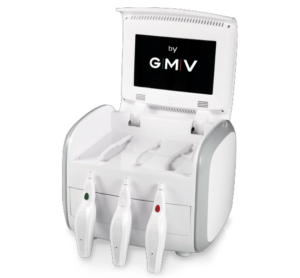Until around 10 years ago, excess skin on the eyelids could only be treated with surgery: upper and lower blepharoplasty. Since then, an innovative medical technique that is non (or only mildly) invasive has been developed as an alternative to surgery. We now talk about non-surgical medical blepharoplasty. This technique has been performed in France for around 7 years.

This involves making the skin on the eyelid retract by causing the most superficial skin cells, called “corneocytes”, to combust (this is pain-free when a local anaesthetic cream is used) without damaging the neighbouring subjacent tissues.
Using a special handpiece, the doctor makes fine combustion points spaced a few millimetres apart, in staggered rows, in order to guide the skin retraction upwards and open up the patient’s expression.
The tiny, brown scabs – called “combustion scabs” – disappear a few days after each session of PlexR or medical blepharoplasty.
The scope of use for this type of technology is vast, but for safety reasons, and due to the straightforward and easily-managed after-effects, Doctor James Schinazi limits the indications of PlexR to the following treatments:
Pregnancy is the main counterindication. Because this is a cosmetic procedure, if there is no rush to have the treatment and the pregnancy is already underway, we can simply continue treatment after the birth, or even later on.
Dark skins (phototype IV or darker) have an increased risk of post-inflammatory hypo- or hyperpigmentation, especially if the scabs are pulled off or scratched.
Doctor James Schinazi always sees patients who want to have this type of non-surgical eyelid treatment for the first time in his practice, so that he can explain the right medical indications and draw up a (free) quote.
During this appointment, he will provide all the necessary explanations to ensure you understand the treatment fully and will prescribe a local anaesthetic cream which should be applied before the next session, around an hour before your appointment, in a thick layer onto cleansed, makeup-free skin (it may be applied in the practice itself).
During the medical blepharoplasty session, the doctor will take “before” photos for your medical records. After carefully disinfecting the area, the PlexR® treatment will begin, without causing any pain or bleeding.
The patient should just feel a slight tingling sensation. At the end of the session, you will see staggered lines of combustion points that will bring about a homogenous, natural and gradual lifting effect in the eyelids.
In the 24 to 48 hours after treatment, the eyelids may swell up. This is temporary swelling and always subsides. This side-effect can be prevented by taking Extranase® (pineapple extract anti-oedema medicine) prior to and after treatment.
The combustion scabs take 3 to 7 days to fall off. It is vital that you do not pick them and do not rub the treated area otherwise it may lead to persistent redness or hypo/ hyperpigmentation.
You should protect your skin from the sun using a non-greasy lotion (SPF 50 +) for 1 month and you can wear a non-greasy foundation to camouflage the scabs if you wish.
After each session, the skin on the eyelids gradually and naturally retracts without any serious after-effects or scars. The results are very even, making the expression look fresher and more open after each session.
On average, you will need a total of 4 sessions, one session per month. The results last for several years. The average fee charged per session varies according to the extent of the treatment, but generally between 250 and 350 euros.
In short, medical blepharoplasty allows us to delay or even avoid surgery in some patients, by carrying out a veritable eyelid lift in a gentle and even way, with a satisfaction rate that increases after every session.
11, avenue Raymond Poincaré
75116 Paris
The practice is on the ground floor, on the right
Tél : 01 56 62 10 77
contact@docteur-schinazi.com
Parking nearby
Metro ligne 6 et 9 Trocadéro
Bus 22, 32, 63, 82